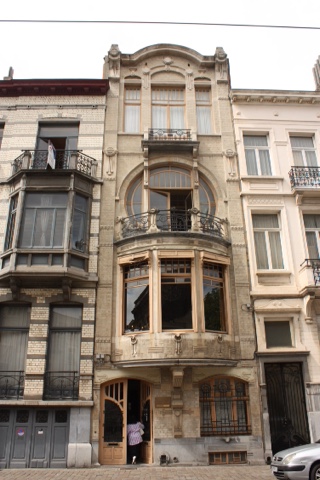Brussels, Belgium
Let me start with one of the most highly regarded foods in Belgium - frites. In the 1700's, inhabitants of the Ardennes would fry little fish from rivers as a food source. In the winter when rivers froze over, they replaced the fish with potatoes cut into the shape of fish. Since then, it has become easier to simply cut them with square edges, but the love of frites remains. There is a counterclaim from the French that they were invented in Paris, but I prefer the first story.
Our first Belgian experience of the golden nibbles was at an inconspicuous restaurant next to Audrey Hepburn's childhood home (allegedly, as we could find no sign of evidence to back up this claim from Lonely Planet). The frites accompanied meaty dishes, some of which were cooked in beer. Belgian beer, of course - another famous consumable from the Belgians (though they did not invent it, as beer brewing can be traced back to ancient Egypt and Mesopotamia). While I had my doubts that fries could be made excellently, as they are just fried potato, I was more than satisfied with the quality of those frites. They were perfectly cooked with a slightly crispy exterior and soft centre, and were very moreish!
Walking off our hearty lunch, we went on an art nouveau tour of Brussels, wandering down long streets and spying round windows and ornate wrought iron.
This Old England building was so art nouveau it was almost steampunk! Though we ran out of time to visit the museum housed inside, we know that it contains over two thousand instruments and the focus is on listening - you can hear how many instruments sound, which seems like a brilliant idea in a music museum.
On our stroll, we saw the so-called prettiest church in Belgium, designed by a student of Reubens'. While it is certainly nice, I have seen much better and soon you will too.
This oddly shaped building was home to the botanic gardens. I thought the roof shape was appropriate, as it looks like an English gentleman's safari hat that has been around the world, its owner collecting all manner of flowering shrubs, cacti and bulbs.
On our way to see another church, we stopped for a break at this art nouveau café called De Ultieme Hallucinatie with fetching stained glass windows.
The foyer held a glinting peacock cabinet and white piano. As usual, Yannick wanted me to pose next to it, but this time I got behind the lens.
At the end of the street was this magnificent church with metallic stars studding the dome. Now isn't this church prettier than the earlier one? I think so, but that may simply be my preference in architectural style. The centred round window! The towering arches and crows nest at the peak! And those stars!
You may have heard of Manneken Pis, a bronze fountain of a boy peeing. I overheard a tour guide telling the story to a group, and it turns out that I badly misheard him, because I thought he told a story like this: a naughty little boy urinated in the street, but where the pee landed happened to be on the doorstep of a witch's house. She turned him to bronze to warn off any future urinators. But upon researching later, none of the legends contain a witch - in fact, in all of the folklore the act of peeing is either a good thing or neutral. The most popular story is that an infant prince was paraded in a basket to raise moral of the troops, and his urination stream fell upon the soldiers. Amusing, and nowhere near the didactic tale of the witch. On a related note, we saw a church in the city that has a pissoir one one of its exterior walls, encouraging people to urinate on it. We didn't get too close.
Elsewhere in Brussels, we found Jeanneke Pis, a female version of Manneken Pis, and the statue of a dog Zinneke (not a fountain) relieving himself on a bollard. Charming.
I suppose these fountains are more politically correct if vomiting is less frowned upon in public than urination. A rabid goat and panther rear up with backbreaking twisting to spew water backwards into the pool. Though sort of grotesque, I enjoyed them. The combination of herbivore (if goats can be called that when they eat everything including tin cans) and carnivore in tandem chunder showed some sense of camaraderie that overcame barriers of the food chain.











No comments:
Post a Comment